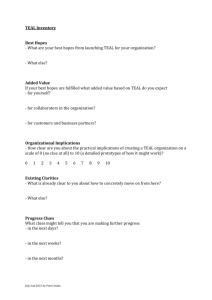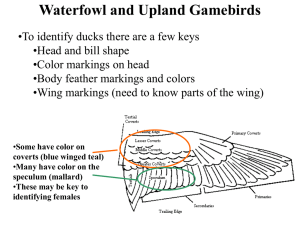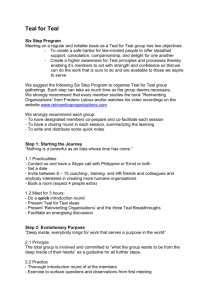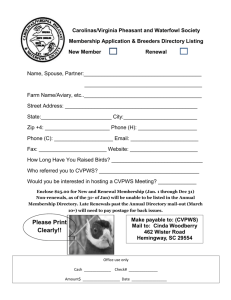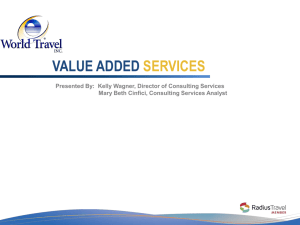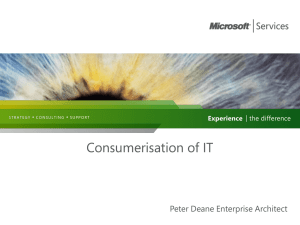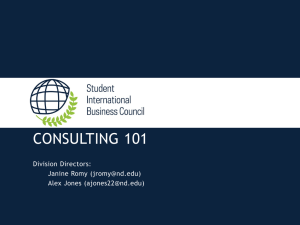Customer Demand in Challenging Times
advertisement
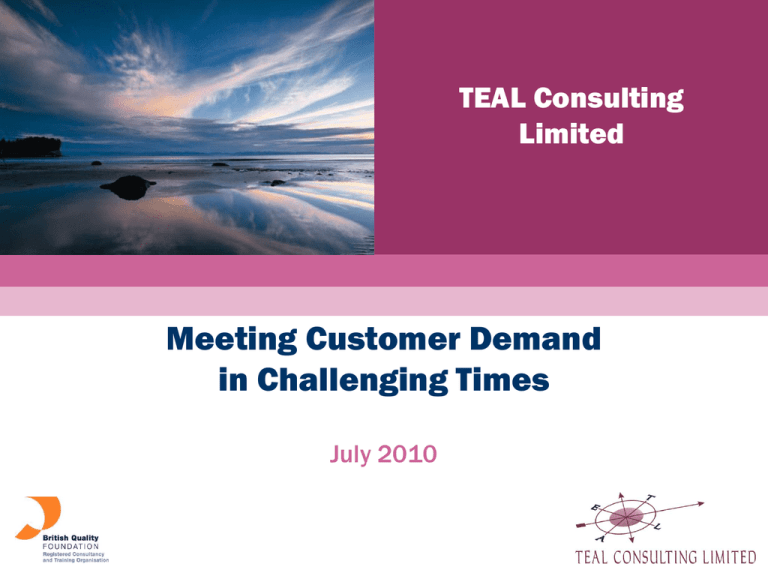
and Learning TEAL Consulting Limited Meeting Customer Demand in Challenging Times July 2010 a a Service Understanding Internal Factors Errors, delays and inefficiencies – plus causes and implications Customer Demand Type, Volume, Variation, Service vs. Failure, NonService Requests, Feedback & Complaints Service Outputs & Outcomes Service Delivery Chain Step 1 Step 3 Step 2 Step n What value and benefit do customers get from the service – what is the impact on related services provided by the organisation? External/Environmental Factors What external constraints are imposed on the service which affect its performance and ability to improve (e.g. economic factors, lack of customer knowledge, unrealistic customer expectations of the service) Slide 2 © TEAL Consulting Limited 2010 Outcomes vs Outputs It's important to understand the difference Processes deliver – OUTPUTS – Recruit Staff - new appointed people OUTCOME - a level of performance or achievement – The staff may be: • at the right time or too late for the line manager • capable or incapable of performing their role • too many or too few Slide 3 © TEAL Consulting Limited 2010 Customer Focused Process SERVICE PURPOSE Desired Outcomes, Success Criteria, KPI’s and Targets CUSTOMER DEMAND Service Requests, Avoidable Contact, Complaints…. SERVICE EFFECTIVENESS Customer Outcomes, Customer Satisfaction/Dissatisfaction SERVICE EFFICIENCY Slide 4 Resources Needed to Satisfy All Demand © TEAL Consulting Limited 2010 What are we trying to achieve Quality People are the glue that hold organisations together Our focus is – variation reduction Q + People C T Cost Our focus is empowerment Time Our focus is – a reduction in the amount of calendar time consumed Our focus is – waste reduction Slide 5 © TEAL Consulting Limited 2010 Cost of Poor Quality COPQ Cost of Non-Conformance Prevention Costs Appraisal Costs Internal Failure Costs Cost of Conformance Slide 6 External Failure Costs © TEAL Consulting Limited 2010 Understanding Customer Requirements Gather meaningful Data on what the Customer requires –Voice of the Customer (VOC) Analyse and Translate VOC into meaningful terms –Critical to Quality standards (CTQ) Slide 7 © TEAL Consulting Limited 2010 Starting with “What is a Customer ?” A Customer is a recipient of the Output of a Process The Customer can be Internal or External External Customers are not limited to end-users of the Product or Service External Customers can also include Regulators, Monitors of Law and the Public or Community (Stakeholders) The definition of Quality here means satisfying Customer Needs Slide 8 © TEAL Consulting Limited 2010 Kano Model of Customer Expectations Service Pressure Satisfaction Delighters Satisfaction Region More is Better Need not Fulfilled Need Fulfilled Dissatisfaction Region Must Have’s Dissatisfaction More is Better needs are generally explicit, Must Have’s and Delighters are usually unspoken Slide 9 © TEAL Consulting Limited 2010 VOC to CTQ : CTQ Tree Speed of Delivery Elapsed Time from Order to Arrival Taste CUSTOMER: “Good room service" Food Quality Presentation Temperature Cost Service Charge Compared with eating in restaurant VOC Critical Customer Requirement General CTQ Specific Hard to measure Easy to measure “Vague” terms Measurable items Slide 10 © TEAL Consulting Limited 2010 Defining Customer CTQs Convert customer data into Specific Requirements Define a Requirement not a Solution Document all the information Ensure the Requirement is Measurable Define the Measure Establish meaningful Specification Limits The acid test is whether the CTQ can be Measured Slide 11 © TEAL Consulting Limited 2010 Runners, Repeaters & Strangers % Vol 100% 95% Repeaters Partially flow Shared processes Some management 80% Strangers One offs Universal processes Significant management Runners Rapid flow Dedicated processes Self managed % Service range 20% Slide 12 © TEAL Consulting Limited 2010 Rolled Throughput Yield Problems in processes have a cumulative effect... Consider the following 3-step process: Input 100 documents A B C Output 90 documents Yield = 90% Is this the whole story? Slide 13 © TEAL Consulting Limited 2010 Rework - Hidden Processing Input 100 Documents A 98 RFT = 94% 6 4 B 93 RFT = 91% 9 4 C Output 90 Documents RFT = 92% 7 4 REWORK 2 5 3 SCRAP What is the true yield (Rolled Throughput Yield) ? Slide 14 © TEAL Consulting Limited 2010 Rolled Throughput Yield Input 100 documents A 98 RFT = 94% B 93 RFT = 91% C Output 90 documents RFT = 92% Rolled Throughput Yield = RFTA x RFTB x RFTC = 0.94 x 0.91 x 0.92 = 79% A true reflection of process performance Slide 15 © TEAL Consulting Limited 2010 Overall Process Effectiveness Element Six Big Losses Description Example Major stops Unable to run - Major stop > 10 minutes IT failure / No staff / No work Transition Losses Delays between activity Minor stops Interruptions. Minor stops < 10 minutes Skill Losses Wrong things or wrong staff Process errors Internal failures Supply errors External failures Availability Performance Quality Awaiting patients or information. Set-up & clean down at start & end of day Unplanned distractions - Phone, email, colleagues Completing unnecessary work or Dr covering on reception Correcting data entry errors / dealing with customer complaints Mistakes made by others - Courier damage / Pathology lab results Source : Lean Toolbox for Service Systems John Bicheno Slide 16 © TEAL Consulting Limited 2010 Exercise Objective – To identify the Customers of your Processes – To consider what improvement could be made in your service effectiveness and efficiency How – List 1 of your service processes – Identify all the Customers of this Process – Internal and External – Consider what measures exist for your processes Output – An understanding of what measures currently exist – An initial assessment of the effectiveness and efficiency of your Processes Slide 17 © TEAL Consulting Limited 2010 Reminder - Customer Value Value is Generated for Customers via – Quality – Cost of Service – Delivery In meeting Customer Needs there is benefit for the organisation in terms of – Right first time – lower number of repeat calls – Lower Costs – Less time wasted – Satisfied customers e.g. rate payers Reduction of Non Value Adding time is a major driver – Minimising amounts of staff time wasted. Slide 18 © TEAL Consulting Limited 2010 External Perspective Waiting time Length of delivery delay B They don’t care about my business; it isn’t worth the wait Perceived service quality Customer traffic Waiting time Time Slide 19 © TEAL Consulting Limited 2010 Internal Perspective Customer Satisfaction Level of customer satisfaction Sales Length of delivery delay We can’t afford these employees Size of service and delivery department Slide 20 © TEAL Consulting Limited 2010 And Finally Understanding what outcome the service is intended to deliver - is the start Understanding how this impacts on quality of service delivery is critical The effectiveness of the service has a direct impact on your costs So jumping to be more efficient before addressing effectiveness is a short term fix – which will come back later Slide 21 © TEAL Consulting Limited 2010
